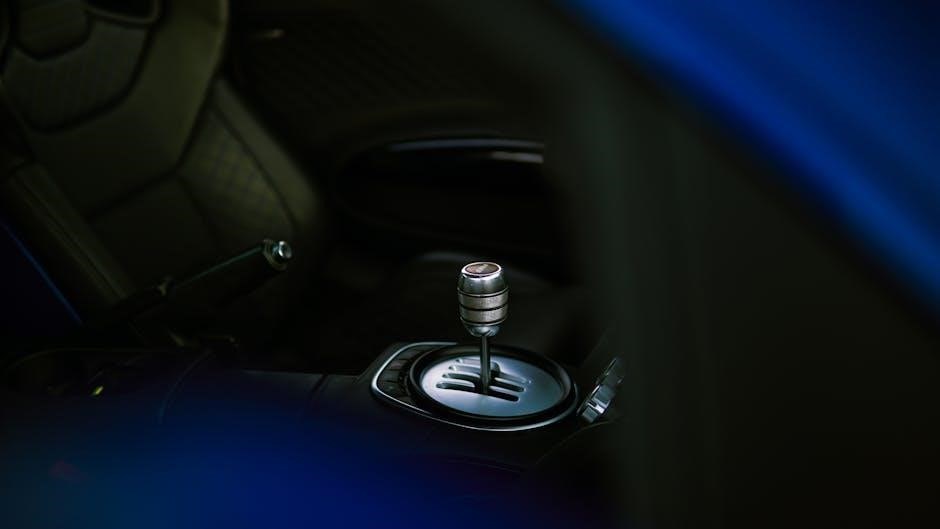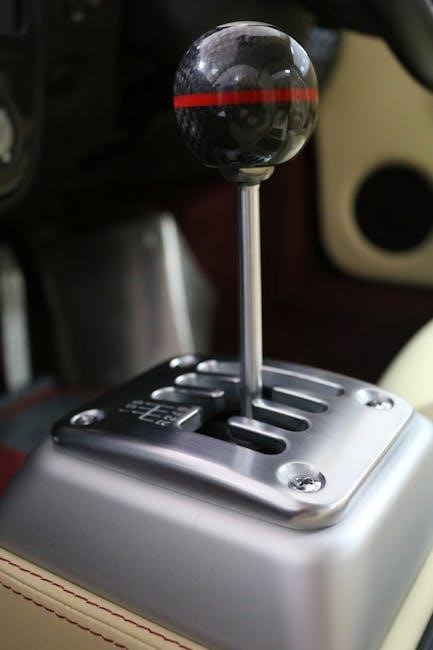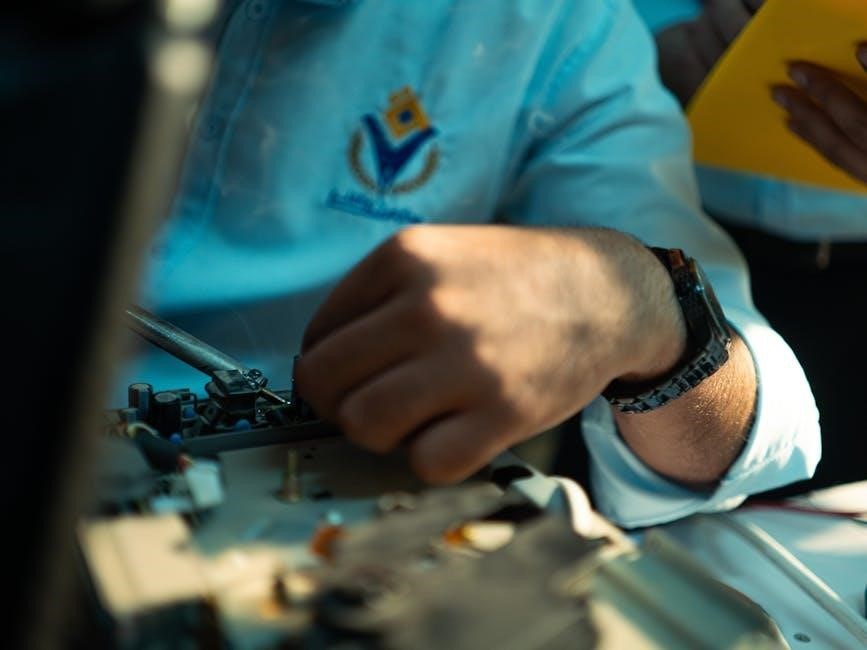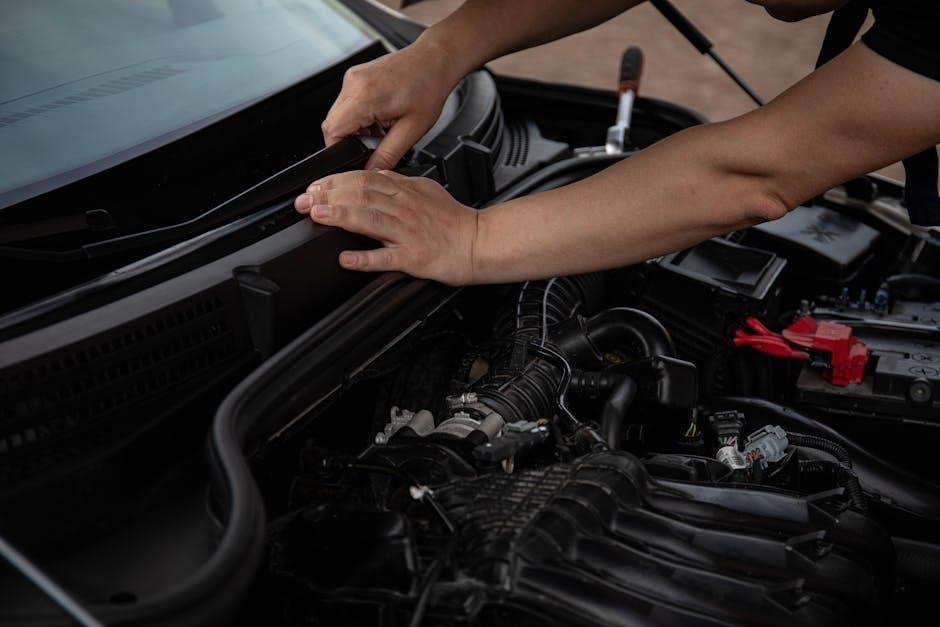manual transmission problems

Manual transmissions, though reliable, can develop issues like clutch failure or hard shifting. Early detection is crucial for cost-effective repairs and maintaining performance over time.
Overview of Manual Transmissions
Manual transmissions are gear systems that require driver input to change gears using a clutch pedal and shift lever. Unlike automatics, they rely on the driver to engage and disengage the clutch, offering better fuel efficiency and control. These systems are generally more reliable and simpler in design, with fewer components compared to automatic transmissions. However, they are not immune to issues, such as clutch failure or hard shifting, which can arise from wear and tear or improper use. Understanding how manual transmissions work is essential for identifying and addressing problems early, ensuring optimal performance and longevity.
Importance of Early Detection
Early detection of manual transmission issues is crucial for preventing minor problems from escalating into costly repairs. Ignoring symptoms like unusual noises or sluggish performance can lead to major damage, requiring expensive overhauls. By addressing problems early, drivers can save time, money, and ensure their vehicle remains reliable. Regular checks and prompt action help maintain optimal performance and extend the lifespan of the transmission. Familiarizing oneself with common symptoms, such as grinding or difficulty shifting, allows for timely intervention. Early detection not only prevents breakdowns but also enhances safety, ensuring the vehicle operates smoothly and efficiently on the road.

Common Manual Transmission Problems
Common manual transmission problems include clutch failure, hard shifting, noisy bearings, gear popping, and low transmission fluid. These issues can lead to breakdowns if left unaddressed.
Clutch Failure
Clutch failure is a common issue in manual transmissions, often caused by wear and tear, aggressive driving, or improper clutch engagement. Symptoms include a slipping clutch, difficulty shifting gears, and a spongy pedal feel. If ignored, it can lead to complete clutch failure, requiring costly repairs. Regular inspection of the clutch and pressure plate is essential to identify worn or damaged components early. Replacing the clutch at the first sign of trouble can prevent further damage to the transmission and ensure smooth operation. Proper driving techniques, such as avoiding riding the clutch, can also extend its lifespan and maintain optimal performance.
Hard Shifting
Hard shifting refers to difficulty engaging gears, often accompanied by a stiff or unresponsive gearshift. This issue can stem from worn or damaged synchronizers, bent shift forks, or low transmission fluid levels. Synchronizers, responsible for aligning gear speeds during shifts, can wear out over time, causing gears to resist engagement. Similarly, physical damage to shift forks or linkages can disrupt the shifting mechanism. Low fluid levels may also reduce hydraulic pressure, making it harder to shift gears smoothly. Addressing hard shifting promptly is crucial, as it can lead to further damage, such as chipped gears or complete transmission failure, if left unchecked.
Noisy Bearings
Noisy bearings are a common issue in manual transmissions, often manifesting as buzzing, clicking, or clunking sounds during operation. These noises typically originate from worn or damaged bearings within the transmission, such as input shaft, output shaft, or gear bearings. Over time, bearings can degrade due to lack of lubrication, high mileage, or excessive wear. If left unaddressed, faulty bearings can lead to more severe problems, including gear damage or complete transmission failure. Regular maintenance, such as checking and replacing bearings, is essential to prevent these issues. Addressing noisy bearings early can help maintain smooth transmission performance and avoid costly repairs down the line.
Gear Popping or Slipping
Gear popping or slipping is a common manual transmission issue where gears disengage unintentionally while driving. This can occur due to worn synchronizers, low transmission fluid levels, or damaged linkages. Synchronizers, responsible for smooth gear transitions, can wear out over time, causing gears to slip or pop out. Similarly, insufficient fluid can reduce hydraulic pressure, leading to improper gear engagement. If left unchecked, this problem can escalate, causing further damage to gears and other components. Addressing the root cause promptly, whether through fluid checks or component replacement, is crucial to prevent costly repairs and ensure smooth transmission operation.
Low Transmission Fluid
Low transmission fluid is a prevalent issue that can significantly impair manual transmission performance. Insufficient fluid levels reduce hydraulic pressure, leading to delayed or sluggish responses, gear popping, and increased wear on internal components. Over time, this can result in premature damage to gears, bearings, and synchronizers. Regular fluid checks are essential to maintain optimal levels, as low fluid can also cause increased friction and heat buildup. If left unaddressed, it may lead to costly repairs. Ensuring the correct fluid level and addressing any leaks promptly can prevent these issues and maintain smooth, reliable transmission operation. Proper fluid maintenance is key to longevity.

Causes of Manual Transmission Issues
Manual transmission issues often stem from worn or damaged linkages, bent shift forks, defective synchronizers, and fluid leaks. These problems can lead to poor shifting and engagement.
Worn or Damaged Linkages
Worn or damaged linkages are a common cause of manual transmission issues. These linkages connect the gearshift to the transmission, enabling smooth gear changes. Over time, they can wear out or become misaligned, leading to difficulty shifting gears or inconsistent engagement. Symptoms include loose shifting, grinding noises, or gears that slip out unexpectedly. If left unaddressed, damaged linkages can cause further damage to the transmission, such as bent shift forks or worn synchronizers. Regular inspection and maintenance of these components are essential to ensure proper transmission function and prevent costly repairs. Addressing linkage issues early can significantly extend the lifespan of your manual transmission system.
Bent or Rusted Shift Forks
Bent or rusted shift forks are a significant issue in manual transmissions, often causing gears to slip or fail to engage properly. Shift forks are critical components that engage gears during shifting. When they become bent or rusted, they can misalign, leading to poor gear engagement and potential damage to synchronizers or gear teeth. Symptoms include difficulty shifting, grinding noises, or gears popping out unexpectedly. Rusted forks may result from moisture exposure, while bending often occurs due to heavy use or improper shifting. Early detection is crucial, as damaged shift forks can lead to costly repairs if left unaddressed. Professional inspection and replacement are typically required to restore smooth transmission operation.
Defective Synchronizers

Defective synchronizers are a common issue in manual transmissions, leading to poor gear engagement and shifting difficulties. Synchronizers are responsible for ensuring smooth transitions between gears by equalizing their speeds. When they fail, drivers may experience grinding noises, hesitation during shifting, or gears that refuse to engage properly. This problem often arises from wear and tear over time, especially in high-mileage vehicles. If left unaddressed, defective synchronizers can cause further damage to gears and other components. Replacing faulty synchronizers is typically necessary to restore proper transmission function and prevent more severe issues from developing. Early detection is key to avoiding costly repairs.

Fluid Leaks and Contamination
Fluid leaks and contamination are significant issues for manual transmissions, though less common than in automatics. Leaks often occur due to degraded seals or damaged gaskets, leading to fluid loss. Contamination happens when debris or dirt enters the system, affecting transmission performance. Low fluid levels can cause gears to overheat and wear prematurely, while contaminants can damage bearings and gears. Regular fluid checks are essential to identify leaks early. Addressing these issues promptly prevents costly repairs and ensures smooth gear engagement. Proper maintenance, such as replacing seals and cleaning the system, is crucial for long-term reliability and optimal performance of the manual transmission.

Symptoms to Watch For
Unusual noises, delayed response, difficulty shifting, and grinding or slipping gears are key indicators of manual transmission issues. Addressing these symptoms early prevents major repairs.
Unusual Noises (Buzzing, Clicking, Clunking)
Unusual noises such as buzzing, clicking, or clunking often signal underlying issues in a manual transmission. These sounds can indicate worn bearings, damaged gear teeth, or faulty synchronizers. Buzzing may point to a failing bearing, while clicking could suggest issues with gear engagement. Clunking noises often occur during shifting, hinting at problems with the shift fork or gear alignment. Ignoring these sounds can lead to more severe damage, such as gear failure or complete transmission breakdown. Regular inspections and prompt repairs are essential to prevent these noises from escalating into costly problems. Addressing them early ensures smoother operation and extends the transmission’s lifespan.
Delayed or Sluggish Response
A delayed or sluggish response in a manual transmission occurs when the car hesitates or lurches during gear shifts. This issue often stems from low transmission fluid levels, worn-out synchronizers, or a failing clutch. Insufficient fluid can prevent proper lubrication, causing gears to engage slowly or inconsistently. Worn synchronizers may fail to mesh gears smoothly, leading to hesitation. Additionally, a slipping or worn clutch can delay the transmission’s response, making it feel unresponsive. Addressing these issues early is crucial, as neglecting them can result in more severe damage. Regular fluid checks and component inspections can help identify and resolve these problems before they escalate.
Difficulty Shifting Gears
Difficulty shifting gears in a manual transmission can stem from worn or damaged components such as synchronizers, shift forks, or linkages. If the synchronizers are worn, they may fail to properly engage gears, making shifting feel stiff or unresponsive. Similarly, bent or rusted shift forks can prevent gears from aligning correctly, leading to resistance or refusal to shift. Low transmission fluid levels or contamination can also cause friction, making gear changes laborious. Ignoring these issues can exacerbate wear and potentially lead to complete transmission failure. Addressing these problems early ensures smoother operation and prevents costly repairs down the line.
Grinding or Lack of Engagement
Grinding or a lack of engagement in a manual transmission often indicates worn or damaged components. This issue can arise from worn-out synchronizers, which fail to properly engage gears, or from a clutch that is not disengaging fully. Additionally, low transmission fluid levels or contamination can cause gears to grind due to insufficient lubrication. If left unaddressed, this can lead to further damage, such as gear teeth wear or complete gear failure. It is crucial to inspect and replace worn parts promptly to restore smooth operation and prevent more severe and costly repairs. Early intervention is key to maintaining transmission health.

Maintenance and Prevention Tips
Regular fluid checks, inspecting linkages, and replacing worn components can prevent major issues. These practices ensure smooth operation and extend the lifespan of your manual transmission system.

Regular Fluid Checks
Regular fluid checks are essential for maintaining manual transmission health. Low fluid levels can cause delayed response, gear slippage, or grinding noises. Use a dipstick to monitor fluid color and consistency; dark or dirty fluid indicates a change is needed. Check for leaks around seals and gaskets, as contamination can damage internal components. Proper fluid levels ensure smooth gear engagement and prevent overheating. Neglecting fluid maintenance can lead to costly repairs, such as synchronizer or bearing replacements. Always refer to your vehicle’s manual for the correct fluid type and inspection procedure to keep your transmission running smoothly and reliably over time.
Inspecting Linkages and Bushings
Inspecting linkages and bushings is crucial for maintaining smooth gear shifts. Worn or damaged components can cause hard shifting or gears dropping out unexpectedly. Check shift linkages for bends, rust, or looseness, as these can disrupt proper gear engagement. Bushings, especially those connecting the shift fork to the transmission, should be inspected for wear or cracks. Damaged bushings can lead to misaligned gears and noisy operation. Regularly lubricating these parts prevents excessive wear. If issues are found, replace worn components promptly to avoid further damage. Neglecting linkages and bushings can result in costly repairs, such as replacing entire shift forks or transmission assemblies.
Replacing Worn Components
Replacing worn components is essential to prevent major transmission damage. Commonly, synchronizers, bearings, and gear teeth wear out over time, leading to hard shifting or grinding noises. If these parts are damaged, they should be replaced promptly to avoid further deterioration. Worn shift forks or linkages can also cause gears to misalign, requiring immediate attention. Using high-quality, OEM-recommended parts ensures proper fitment and longevity. Regularly inspecting and replacing worn components can significantly extend the life of your manual transmission. Neglecting these replacements can lead to costly overhauls or even complete transmission failure, emphasizing the importance of proactive maintenance.
Manual transmissions remain popular for their durability and driver engagement. Future trends may include advanced materials and smarter designs, enhancing reliability and performance while maintaining their classic appeal.
Advancements in Manual Transmission Technology
Advancements in manual transmission technology are transforming the driving experience. Modern designs now incorporate lightweight materials and improved gear ratios for better fuel efficiency and smoother shifting. The General Motors 8L family of transmissions, introduced in 2014, exemplifies this trend, offering enhanced performance and reliability. Additionally, the integration of advanced synchronizers and bearings reduces noise and wear, addressing common issues like hard shifting and noisy bearings. These innovations ensure manual transmissions remain relevant in a competitive market, blending tradition with cutting-edge engineering to meet driver demands for both performance and durability.
Expert Advice for Long-Term Reliability
Experts emphasize the importance of regular maintenance to ensure long-term reliability of manual transmissions. Routine checks of transmission fluid levels and condition are essential, as low or contaminated fluid can lead to premature wear. Inspecting linkages, bushings, and shift forks for damage or rust is also critical. Replacing worn components, such as synchronizers or bearings, promptly can prevent more severe issues. Additionally, smooth driving practices, like avoiding aggressive shifting or riding the clutch, can significantly extend the lifespan of the transmission. By addressing problems early and adhering to a consistent maintenance schedule, drivers can enjoy optimal performance and reliability for years.

